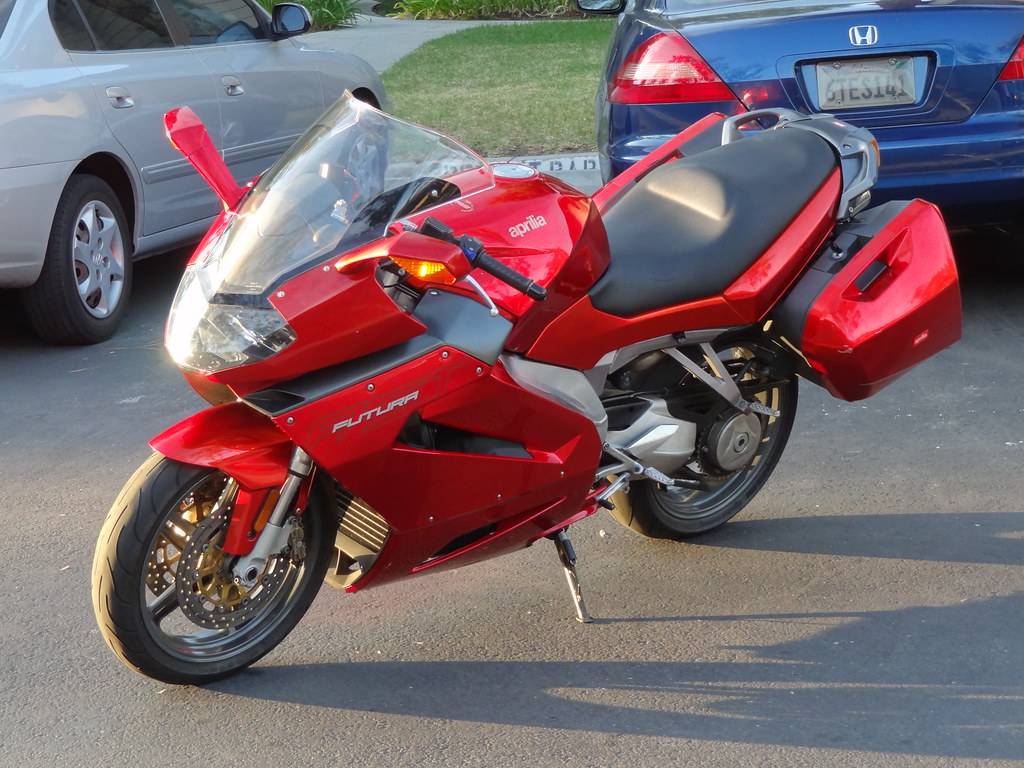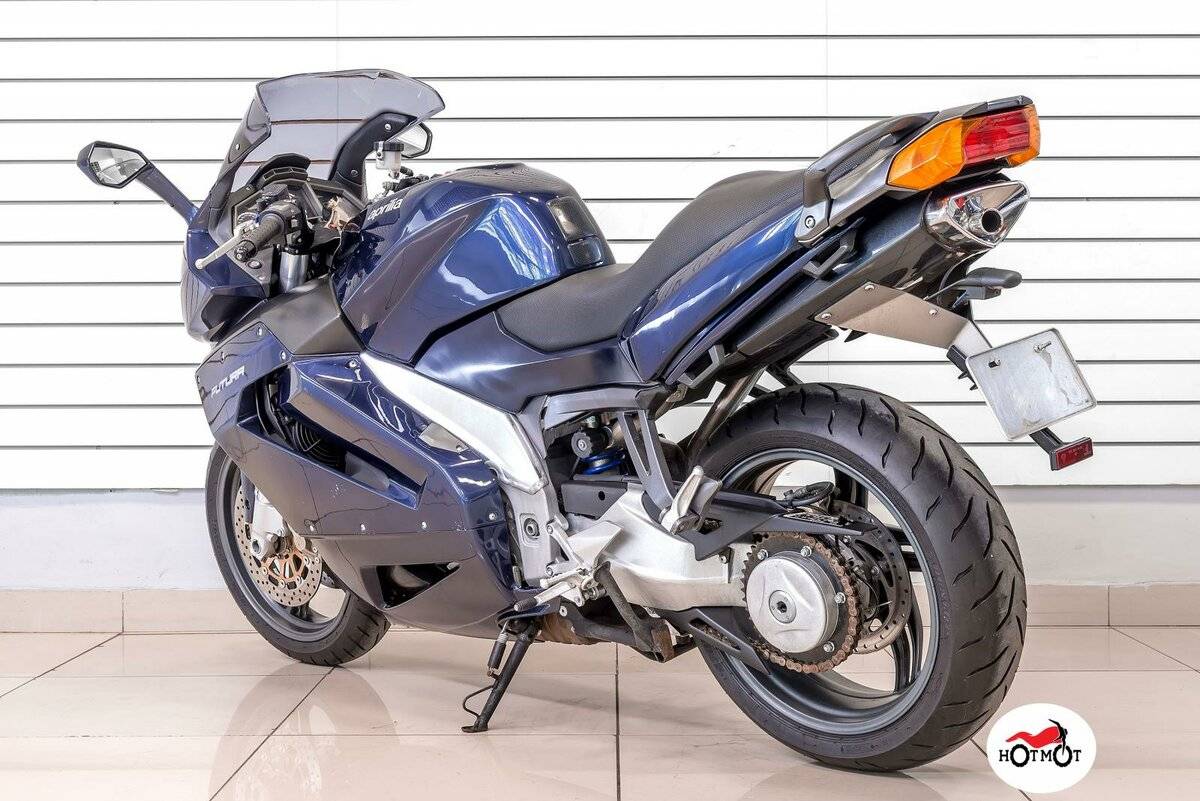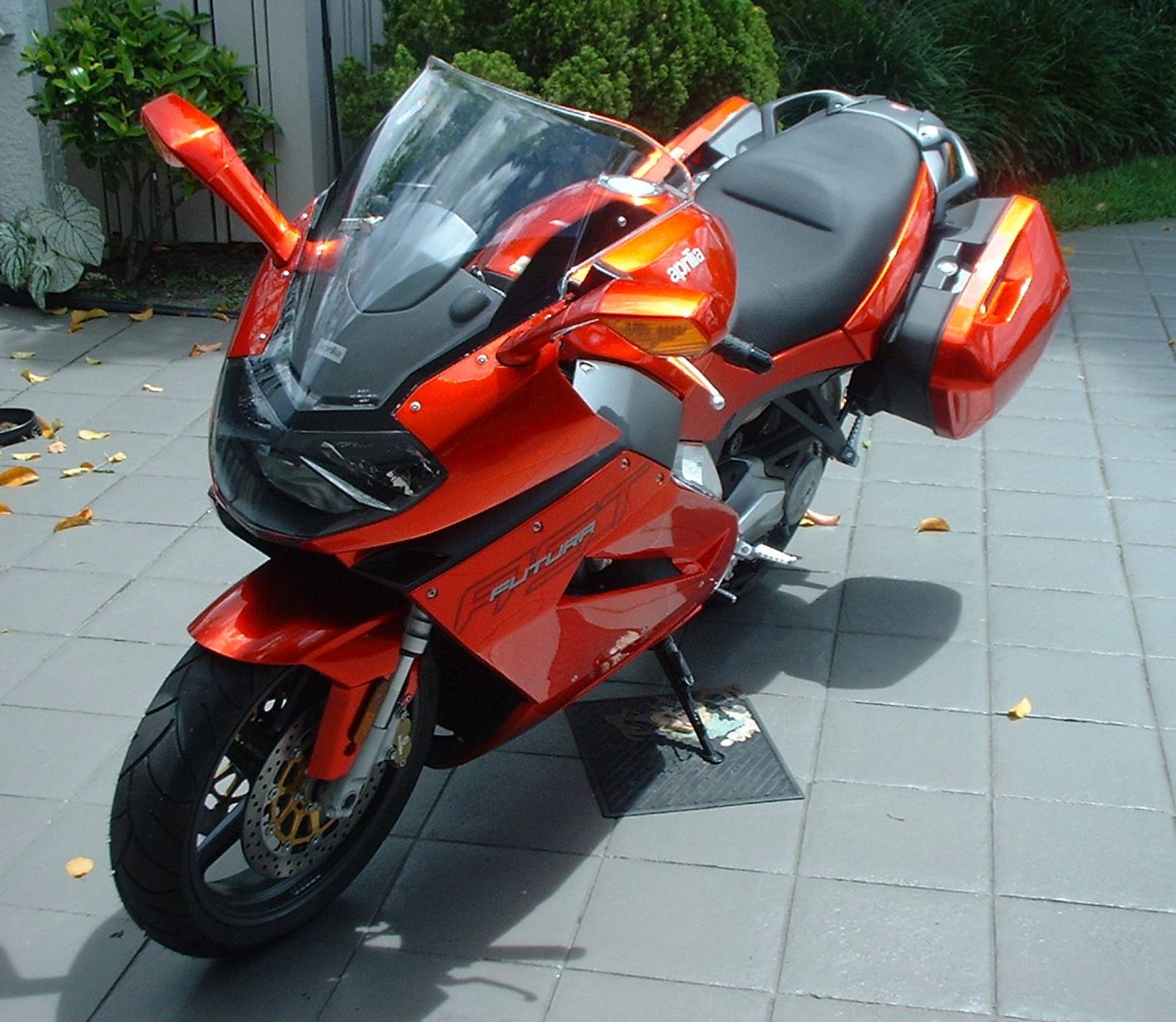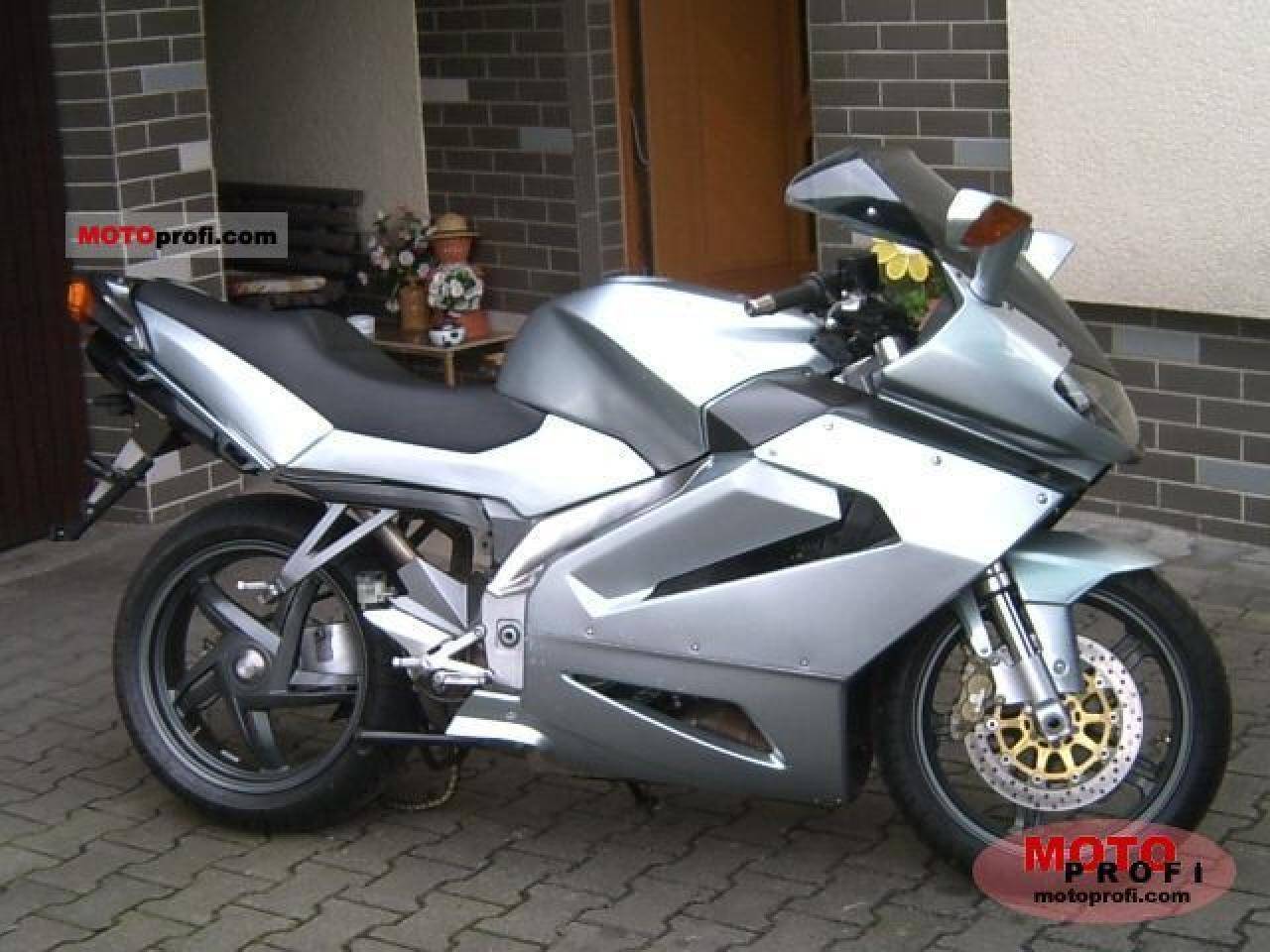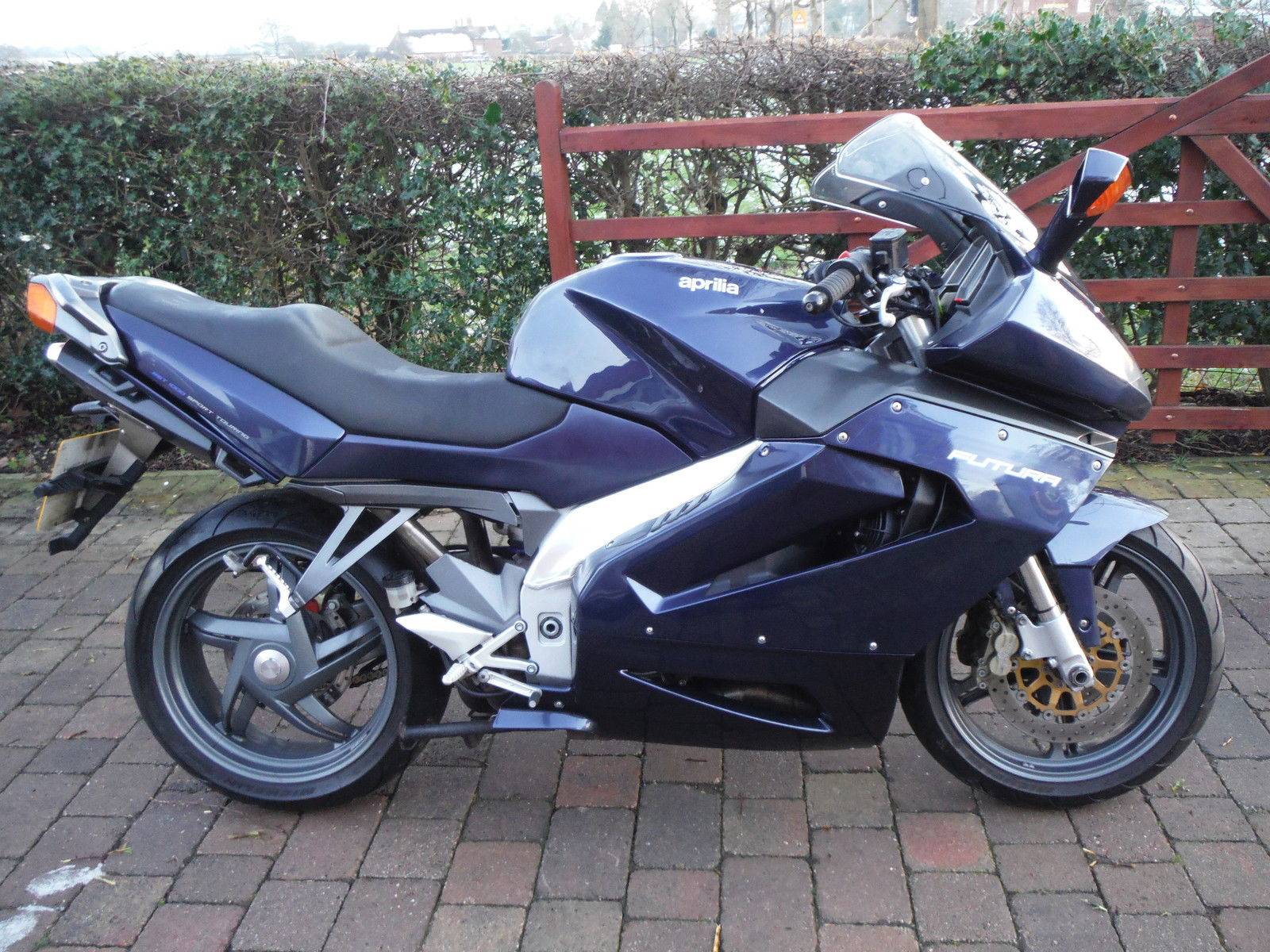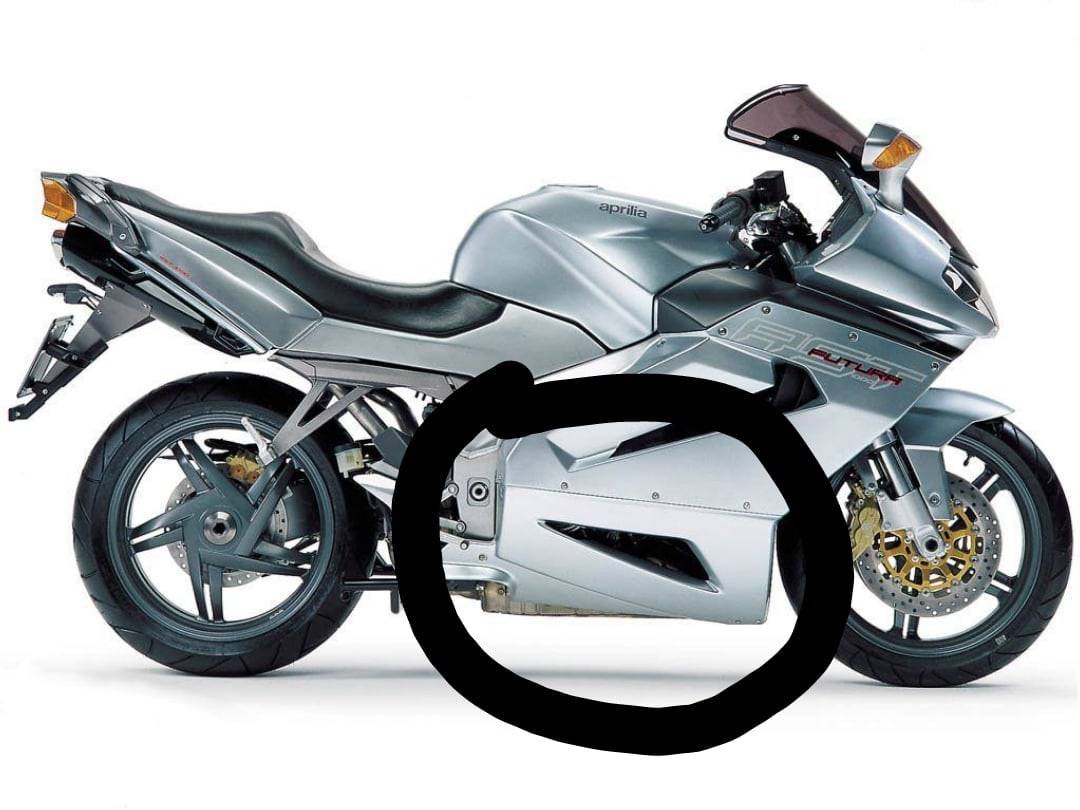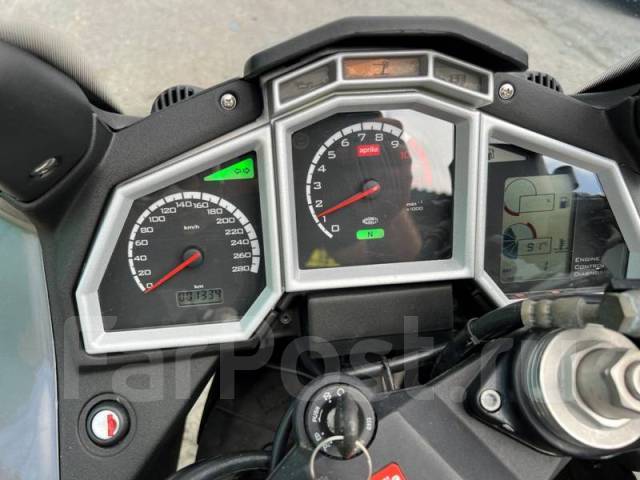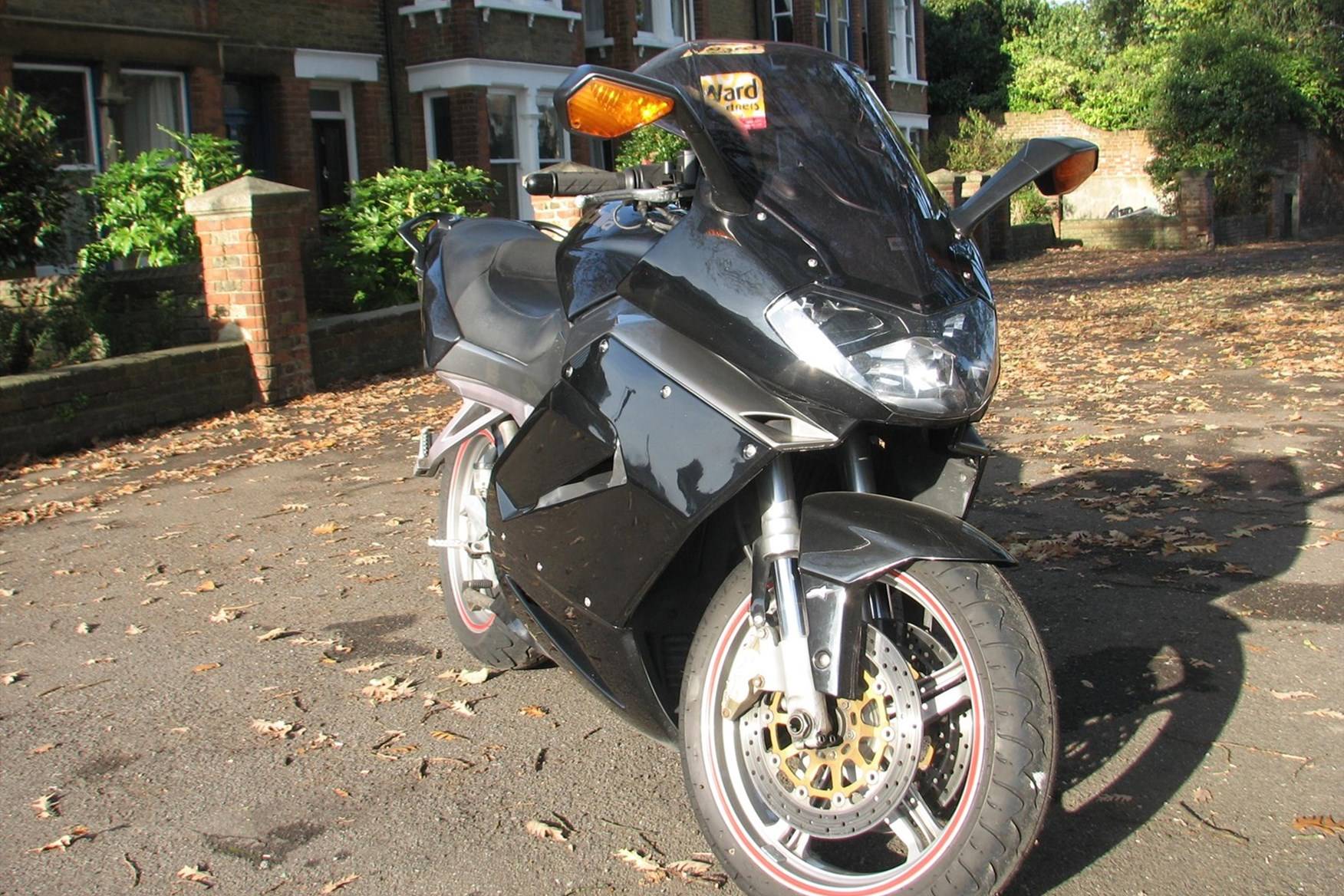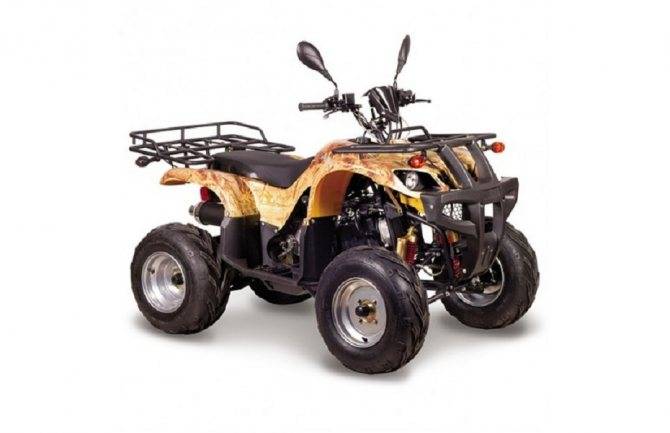WALLOW FREE[edit | edit source]
A tendency for bikes with loaded panniers to wallow is overcome on the Futura with the easily adjustable rear preload on the Sachs shock, allowing the rider to quickly adjust the spring according to load.
Winding the remote knob up to two clicks short of maximum improved the steering as well, as it effectively raises the rear ride-height. The trade-off, of course, is a firmer rear end – not of the tooth-rattling kind however. The rebound damping is also adjustable.
The USD front forks are well-controlled, with just preload and rebound adjustment available, even though the compression adjustment furniture is still there in blanked off form.
Compression adjustment isn’t missed on this bike however, with the standard suspension settings doing a great job of keeping the front tire in contact with the road in most usage.
In fact the suspension is excellent in the real world it was designed for, the odd pothole I did manage to nail prompting nothing but a thump from the Michelin Pilot Sports, all the while the bike ploughing on as though nothing had happened.
WALLOW FREE[edit | edit source]
A tendency for bikes with loaded panniers to wallow is overcome on the Futura with the easily adjustable rear preload on the Sachs shock, allowing the rider to quickly adjust the spring according to load.
Winding the remote knob up to two clicks short of maximum improved the steering as well, as it effectively raises the rear ride-height. The trade-off, of course, is a firmer rear end – not of the tooth-rattling kind however. The rebound damping is also adjustable.
The USD front forks are well-controlled, with just preload and rebound adjustment available, even though the compression adjustment furniture is still there in blanked off form.
Compression adjustment isn’t missed on this bike however, with the standard suspension settings doing a great job of keeping the front tire in contact with the road in most usage.
In fact the suspension is excellent in the real world it was designed for, the odd pothole I did manage to nail prompting nothing but a thump from the Michelin Pilot Sports, all the while the bike ploughing on as though nothing had happened.
Specifications[edit | edit source]
| Make Model | Aprilia RST 1000 Futura |
| Year | 2001 |
| Engine | Liquid cooled, four stroke, longitudinal 60°V twin, DOHC, 4 valves per cylinder |
| Capacity | 997.6 |
| Bore x Stroke | 97 x 67.5mm |
| Compression Ratio | 11.8:1 |
| Induction | Fuel injection |
| Ignition / Starting | Digital electronic with two spark plugs per cylinder / electric |
| Max Power | 113 hp 83 KW @ 9250 rpm (rear tire 101.8 hp @ 9250rpm) |
| Max Torque | 7.78 kg-m 96 Nm @ 7250 rpm |
| Transmission / Drive | 6 Speed / chain |
| Front Suspension | Showa upside-down 43mm fork, adjustable in brake, rebound and preload. 120mm wheel travel |
| Rear Suspension | Swing arm in Aluminum alloy, progressive linkage. Sachs hydraulic shock absorber, adjustable in brake, rebound and preload |
| Front Brakes | 2x 320mm discs 2 piston calipers |
| Rear Brakes | Single 255mm disc 2 piston caliper |
| Front Tyre | 120/70 ZR17 |
| Rear Tyre | 180/55 ZR17 |
| Dry-Weight | 210 kg |
| Fuel Capacity (res) | 21 Liters (5L) |
| Consumption average | 18 km/lit |
| Standing ¼ Mile | 11.6 sec / 123 mp/h |
| Top Speed | 239 km/h |
| Reviews | Motorcyclist / Motorsport it / Comparator Sport Tourer / Motociclismo / Motocorse / Motorcycle.com 1 – Motorcycle.com 2 – Motorcycle.com 3 |
Overview[edit | edit source]
Ace Futura Story Sam MacLachlan A sportster with a comfy seat, or a tourer with sticky tires? Aprilia’s Futura blends fast with practical for a mile-eater with attitude.
It’s not often you see a bike with panniers sporting a set of sticky Michelin Pilot Sports. Or mixing a single-sided swingarm with quality pillion accommodation. The Futura does, and the result? A bike that can transport the rider large distances in comfort, yet still get up and boogie when the situation allows (demands?) it.
These features were perfectly suited to a recent mission of mine, which involved riding to Tumut (NSW) from my Melbourne home base to meet up with my Sydney-domiciled girlfriend, Bec – the hastily-arranged solution to an air travel (or lack of) problem!
Starting out from Melbourne around 5.00pm on a Friday meant battling traffic to the city outskirts, then a leisurely drone up the Fume Freeway and Snowy Mountains Highway in order to make Tumut at something resembling a decent hour.
Ссылки [ править ]
- . Мотоциклист онлайн.
- “Априлия Футура” . Проверено 27 марта 2012 года .
- ^ “APRILIA RST 1000 FUTURA – ЛУЧШИЕ ИСПОЛЬЗУЕМЫЕ ВЕЛОСИПЕДЫ” . Проверено 27 марта 2012 года .
- ^ «Развитие Futura – Внутренняя история» . Архивировано из оригинала на 4 марта 2011 года . Проверено 27 марта 2012 года .
- ↑ Кэткарт, Алан (23 июня 2010 г.). «Бенелли Блюз» . Австралийские мотоциклетные новости . 59 (25): 10.
- ^ “APRILIA RST1000 FUTURA (2001-2003) Обзор” .
| vтеМотоциклы Aprilia | ||
|---|---|---|
| Стандартный / Голый |
| |
| Спорт |
| |
| Супермото |
| |
| Двойной спорт / внедорожник |
| |
| Другие мотоциклы |
| |
| Гоночные мотоциклы |
| |
| Дизайнеров |
| |
| Гонщики |
| |
| Другой | ||
| Группа Piaggio |
Design[edit | edit source]
The Futura incorporated an aluminum-alloy, double-parallel-beam frame with a single-sided swinging arm. Transmission is via a six-speed gearbox and chain-final drive. Other features included CDI dual ignition system using two spark plugs per cylinder, dry sump lubrication, mixed gear/chain timing, (AVDC) double-balance countershaft, and power-assisted hydraulic-controlled clutch, with a patented Pneumatic Power Clutch” (PPC) to simulate a slipper clutch to control rear-wheel bounce during sudden deceleration. The Futura’s dry weight is 210 kg (463 lb).
The chief designer in charge of the project was Pierluigi Marconi. He would design the Futura around the same motor used in the Mille, a 998cc DOHC 60 degree V-twin. Among major changes from the Mille were the single side swing arm and undertail exhaust used to retain space for the hard sided luggage.
Marconi also specified an increase in the electrical generator in order to cope with accessories that touring riders were sure to add. Electrical capacity was increased by 30% over that of the Mille. Marconi directed his design team to spend an extensive amount of time on the exhaust system. The result was that it did not heat up the seat as other undertail exhausts did. It also passed Euro 1 standard emissions without the catalytic converter. The design team moved to supplier Sagem to provide the fuel injection and intake systems.
Marconi would later quit to work with Benelli and then later Gas-Gas. It is his leaving Aprilia that caused promised updates like ABS and power outlets to never materialize on the Futura.
RST1000 Futura 2000
Мотоцикл Aprilia RST1000 Futura – сложнейший по конструкции ворвался в элиту мотостроения, где вынужден конкурировать с признанными грандами класса – Honda VFR, Triumph Sprint ST и Ducati ST4. При этом, мотоцикл сделан с большим акцентом на “спорт”, нежели на “кофортабельный турер”. Дизайн мотоцикла выполнен известным ателье из Римини, которому принадлежит разработка всего модельного ряда компании Bimota и стиль BMW K1200RS. Главный конструктор RST1000 Futura – Пьер Луиджи Маркони обернул новое шасси вокруг слегка измененного двигателя Aprilia V990 – V-twin жидкостного охлаждения с системой впрыска топлива Sagem и с углом развала 60 градусов. Основными отличиями значатся два балансирных вала и сдвоенной системы зажигания (по 2 свечи на цилиндр).
Подробности материала
- Модель
RST1000 Futura 2000-2004 - Марка
Aprilia - Страна производитель
Италия - Модельный год
2000 - Класс мототехники
Туринг - Тип двигателя
двухцилиндровый, 4-тактный, V-образный 60°, две свечи на цилиндр.anti-vibration double countershaft (AVDC patent) - Число цилиндров
2 - Число тактов
4 - Зажигание / Запуск
Электронная (CDI, TSI) / Электростартер - Объем двигателя, см3
997.62 - Степень сжатия
11,4:1 - Система газораспределения
DOHC - Клапанов на цилиндр
4 - Система охлаждения
Жидкостная - Диаметр цилиндра и ход поршня, мм
97 x 67,5 - Мощность, кВт/л.с. @ об/мин
84 / 113 @ 9950 - Крутящий момент, Нм @ об/мин
96 @ 9 250 - Карбюратор (кол-во x тип)
Integrated electronic engine regulation system. Indirect multipoint electronic injection - Ø диффузора, мм
51 - Сцепление
Многодисковое, в масляной ванне. Multiple disk in oil bath with power-assisted hydraulic control (PPC patent) - Система смазки
сухой картер, отдельный маслобак - Очистка ОГ
Материал – stainless steel, two in one in two in one, общим объемом 15 литров - Максимальная скорость, км/час
244 - Расход, л / 100 км
7,8 - Объем топливного бака, л
20.5 - Главное передаточное число
60/31 (1.935) - 1-я передача
35/14 (2.5) - 2-я передача
28/16 (1.75) - 3-я передача
26/19 (1.368) - 4-я передача
24/22 (1.091) - 5-я передача
22/23 (0.957) - 6-я передача
23/27 (0.852) - Число передач
6 - Рама
Диагональная, алюминиевый сплав. - Передняя подвеска
Передняя перевернутая вилка Showa c настройкой усилия отбоя (43мм) - Ход передней подвески
120 - Задняя подвеска
Односторонний маятник Monobraccia - Ход задней подвески
120 - Передние тормоза
Дисковые, 2×298мм, четырехпоршневая скоба - Задние тормоза
Дисковый, 255мм, двухпоршневая скоба - Привод
Цепь 43/16 - Колесная база, мм
1435 - Высота сидения, мм
830 - Передние колеса
3.50 X 17″ - Задние колеса
5.50 X 17″ - Передние шины
120 / 70 ZR 17 tubeless radial; - Задние шины
180 / 55 ZR 17 tubeless radial; - Длина, мм
2170 - Ширина, мм
740 - Высота, мм
1220 - Угол наклона вилки, °
26 - Вылет передней вилки, мм
102 - Сухая масса, кг
235 - Количество мест
2 - Генератор, Вт
470
Познавательный
Представитель: Avto Triglav doo, Dunajska 122, Любляна
Условия гарантии: 1 год, без ограничения пробега
Predpisani servisni intervali: первое обслуживание через 1.000 км, затем каждые 7.500 км
Цветовые сочетания: metalik sivosrebrna in modrovijoličasta
Оригинальные аксессуары:
— stranska kovčka 119.898
– сумка на бак 28.862
— ključavnica body guard 23.642
Количество официальных дилеров / ремонтников:
12 официальных дилеров и ремонтников; 11 авторизованных сервисных техников
Техническая информация
двигатель: 4-taktni — V 2-valjni, kot 60 stopinj, suhi karter, ločen rezervoar olja — tekočinsko hlajen, dva hladilnika — oljni hladilnik — dve gredi za dušenje vibracij AVDC — po 2 odmični gredi v glavi, veriga in zobniki — 4 ventili na valj — vrtina in gib 97 × 67, 5 mm — prostornina 997, 62 cm3 — kompresija 11, 4 — deklarirana največja moč 83, 1 kW (113 KM) pri 9.250/min — deklariran največji navor 96 Nm pri 7.250/min — vbrizg goriva Sagem s samodejnim čokom, sesalna grla f 51 mm — 2 svečki na valj — neosvinčeni bencin (OŠ 95) — akumulator 12 V, 12 Ah — alternator 540 W — električni zaganjalnik
Передача энергии: primarni zobniški prenos z ravnim ozobljenjem, razmerje 1, 935 — hidravlično vodena večploščna sklopka v oljni kopeli, blažilnik momenta PPC — 6-stopenjski menjalnik, prestavna razmerja: I. 2, 50; II. 1, 750; III. 1, 368; IV. 1, 091; V. 0, 957; VI. 0, 852 — veriga (z verižnikoma 16/43)
Рамка: коробка алюминиевая из литых элементов – угол наклона головки рамы 26 градусов – передняя часть 102 мм – колесная база 1435 мм
Подвеска: передняя телескопическая Showa f 43 мм, регулируемая в выдвижении, ход 120 мм – задний алюминиевый маятник, центральный амортизатор Sachs, регулируемое выдвижение и предварительная нагрузка пружины, ход колеса 120 мм
Колеса и шины: классический, со спицами, прикрепленными к краю кольца, переднее колесо 3, 50 × 17 с резиной 120 / 70-17 – заднее колесо 5, 50 × 17 с резиной 180/55-VR17, резина без камер Metzeler.
Тормоза: spredaj 2 × plavajoči kolut Brembo f 300 mm s 4-batno čeljustjo — zadaj kolut f 255 mm z 2-batno čeljustjo
Яблоки оптом: dolžina 2170 mm — širina 740mm — višina (na oklepu) 1220 mm — višina krmila od tal 1140 mm — višina sedeža od tal 820 mm — višina krmila od tal 845 mm — posoda za gorivo 21 l/5 l rezerva — masa (z gorivom, tovarna) 210 kg
Емкости (заводские): не указаны
Наши измерения
Максимальная скорость: 240 КМ / ч
Масса с жидкостями (и инструментами): 244 кг
Расход топлива:
normni krog: 5, 82 l/100 km
najmanjše povprečje: 5, 6 l/ 100 km
Гибкость от 60 до 130 км / ч:
III. prestava: 5, 4 s
IV. производительность: 6, 8 с
V. исполнение: 8, 1 п.
VI. prestava: 9, 9 s
Тестовые задачи: Z izrabljeno zadnjo gumo opazno poslabšanje voznih lastnosti
Хвалим:
+ живой двигатель
+ просторное пространство
+ аэродинамическая защита
Мы ругаем:
— malce težko krmilo pri majhni hitrosti
– не имеет опции ABS
– Телефонный ящик и мелкие предметы отсутствуют
Ocena: Aprilia ima še en motocikel, ki vzbuja pozornost. Močan argument za je dejstvo, da je sestavljen na znani tehnični platformi, zato zanesljivost in vzdrževanje ne smeta biti vprašljiva. Je naklonjen športno živahni vožnji in hkrati dovolj udoben za dva. Še vedno velja naše mnenje, da tak motocikel potrebuje elektronsko pomagalo zavoram. ABS, skratka.
Итоговая оценка: 4/5
Текст: Митя Густинчич
Фото: Урош Поточник.
ALICE SPRINGS[edit | edit source]
The finish all round is very good, as to be expected from Aprilia, with the panniers remaining watertight even through a thorough downpour for instance, and the single-sided swingarm a well executed touch of class.
More and more, the line between sportsbikes and sportstourers is becoming blurred, with bikes built for comfort able to provide genuine real world sportsbike performance – the Futura is one of these.
Against the RST in the marketplace are Ducati’s 916-engined ST4 at $18,995 and 996-engined ST4S at $20,995, BMW’s R1100 S at $17,820 and R1150 RS at $19,900, and Aprilia’s own Falco at $18,975. Throw in Honda’s VFR800 (current 2001 model) at $15,690 and Triumph’s Sprint ST at $15,490 and there’s plenty to choose from.
The $19,990 RST1000 represents another step forward for Aprilia, and is well and truly up with the established competition in the company’s first attempt – an admirable achievement and one I enjoyed sampling.
THE STEED[edit | edit source]
The Aprilia Futura was first unveiled late last year, prior to its worldwide launch in early 2001. It’s the result of Aprilia’s desire to become a major player in the world’s motorcycle marketplace, and therefore compete in a number of market sectors.
While the $19,990 Futura – or RST1000 – has a modified version of Aprilia’s established 60-degree, liquid-cooled V-twin, it’s wrapped in its own twin-spar aluminum chassis.
The chassis is one reason the fully-loaded Futura was impressive through Melbourne’s tin-top maze as I made my escape from Horror HQ.
The rake and trail figures (26 degrees and 102mm) were conceived with easy low-speed handling in mind, and have succeeded admirably. Numerous full-lock U-turns for the photoshoot also proved the point, the RST displaying manoeuvring agility an out-and-out sportster doesn’t have a hope of matching.
Once clear of the Melbourne traffic and on the Hume, with the on-board temperature display reading a fresh 11 degrees, the Aprilia’s mile-eating nature began to shine through.
The large screen, whilst non-adjustable, did an excellent job of confining the breeze to level with my shoulders and above – leaving my helmet in clean air with little buffeting or excessive noise.
One interesting omission from such a bike is rubber-topped footpegs – for either the rider or pillion. While the vibes through the pegs aren’t numbing, the bike would definitely be more comfortable with them.
MOUNTAIN CLIMBING[edit | edit source]
The next day Bec and I headed off to take a look at the Yarrangobilly Caves, around 85km further down the Snowy Mountains Highway.
Once into the twisties and heading up the mountain, I tried in vain to cause the Sagem fuel injection to play up. Rolling open the throttle from closed just saw forward motion resume with no missing, coughing or hesitation.
The engine, whilst claiming less power than its RSV brother at 113ps at 9250rpm, still powered us up the mountain in style, all the while emitting a quiet but satisfying growl.
I found bouncing the needle off the 9500rpm redline proves unnecessary with this powerplant. Smoother, more enjoyable drive comes from short-shifting just above maximum torque (9.78kg-m at 7250rpm) at around 8000rpm, it certainly makes it easier for the pillion hanging on to the excellent grab rails.
The gearbox on our testbike got better as it warmed up, but was a little notchy when cold. Shifting gears was still easy, and the hydraulically-operated clutch (with adjustable lever of course) was nice to use.
I was enjoying myself so much, I was a little surprised to feel a tap on the leg from Bec, before she asked me to pull over. “What’s up?” I asked.
“It’s snowing,” she pointed out in a tone that suggested continuing would be bad for my health, one way or another. Message understood, we turned around and gingerly made our way back to safer altitudes. I wasn’t game to check the temperature at that stage!
Overview[edit | edit source]
Ace Futura Story Sam MacLachlan A sportster with a comfy seat, or a tourer with sticky tires? Aprilia’s Futura blends fast with practical for a mile-eater with attitude.
It’s not often you see a bike with panniers sporting a set of sticky Michelin Pilot Sports. Or mixing a single-sided swingarm with quality pillion accommodation. The Futura does, and the result? A bike that can transport the rider large distances in comfort, yet still get up and boogie when the situation allows (demands?) it.
These features were perfectly suited to a recent mission of mine, which involved riding to Tumut (NSW) from my Melbourne home base to meet up with my Sydney-domiciled girlfriend, Bec – the hastily-arranged solution to an air travel (or lack of) problem!
Starting out from Melbourne around 5.00pm on a Friday meant battling traffic to the city outskirts, then a leisurely drone up the Fume Freeway and Snowy Mountains Highway in order to make Tumut at something resembling a decent hour.
Design[edit | edit source]
The Futura incorporated an aluminum-alloy, double-parallel-beam frame with a single-sided swinging arm. Transmission is via a six-speed gearbox and chain-final drive. Other features included CDI dual ignition system using two spark plugs per cylinder, dry sump lubrication, mixed gear/chain timing, (AVDC) double-balance countershaft, and power-assisted hydraulic-controlled clutch, with a patented Pneumatic Power Clutch” (PPC) to simulate a slipper clutch to control rear-wheel bounce during sudden deceleration. The Futura’s dry weight is 210 kg (463 lb).
The chief designer in charge of the project was Pierluigi Marconi. He would design the Futura around the same motor used in the Mille, a 998cc DOHC 60 degree V-twin. Among major changes from the Mille were the single side swing arm and undertail exhaust used to retain space for the hard sided luggage. Marconi also specified an increase in the electrical generator in order to cope with accessories that touring riders were sure to add. Electrical capacity was increased by 30% over that of the Mille. Marconi directed his design team to spend an extensive amount of time on the exhaust system. The result was that it did not heat up the seat as other undertail exhausts did. It also passed Euro 1 standard emissions without the catalytic converter. The design team moved to supplier Sagem to provide the fuel injection and intake systems.
Marconi would later quit to work with Benelli and then later Gas-Gas. It is his leaving Aprilia that caused promised updates like ABS and power outlets to never materialize on the Futura.
DASH IT ALL[edit | edit source]
The dash is well laid out, utilising an easy-to-read clock-style speedo in place of the RSV and RS250’s LCD displays, and glows a funky blue in low light. There are also comprehensive idiot lights, as well as LCD engine temperature and fuel gauges, and a single trip meter, all accurate and handy for the long haul.
A keyhole on the left of the dash intrigued me though – what the hell was it for? Turning it didn’t seem to do anything at first. It turned out to be the seat release, which allows the entire seat unit to be lifted, rear side panels and all!
There isn’t room underneath for anything much larger than the adequate Aprilia tool kit. That’s what the optional panniers ($1,209) are for I guess.
The panniers are a decent size too, the under-seat exhaust meaning the panniers are of equal size due to not needing to make room for a muffler.
I reckon the muffler looks good from behind, and in fact liked the styling in general, although the looks received a mixed reaction from various people.
Talk centred around the angular fairing, and the fact it could date quickly – only time will tell…
The mirrors, too, are part of the whole styling exercise, incorporating the indicators in the mirror body. The left mirror on the test bike vibrated excessively, making the view a blur, while the right mirror performed adequately, though a little small.
2003 Aprilia RST 1000 Futura[edit | edit source]
The 2003 MY Aprilia RST 1000 Futura has, at its heart, a liquid-cooled, four-stroke, 998cc, V-Twin powerplant paired to a six-speed manual transmission, and can produce a claimed 113 horsepower and 96 Nm of torque. This machine comes standard with a aerodynamic fairing and a medium-sized windshield, offering excellent protection against whatever mother nature may throw at you, a high-end suspension package composed of a inverted front fork and an adjustable shock absorber as a rear suspension, dual front disc brakes for increased safety and can be fitted with modern panniers and a rear trunk, for extra storage space.
2005 Aprilia RST 1000 Futura[edit | edit source]
The 2005 MY Aprilia RST 1000 Futura sports a liquid-cooled, four-stroke, 998cc, V-Twin powerhouse mated to a six-speed manual transmission and can produce a claimed 113 horsepower and 96 Nm of torque. This sportbike addresses those riders who want to spend more time behind the bars, thanks to features such as improved ergonomics, a more comfortable riding position, side panniers, and a full-fairing with a small windscreen.
2001 Aprilia RST1000 Futura in red
The Aprilia RST1000 Futura was a V2, sport touring motorcycle that was produced by Aprilia from 2001 to 2005. It is equipped with a 113 horsepower (85 kW) four-stroke 60° V-twin engine with electric-start, liquid cooling and electronic fuel-injection. The engine is broadly similar to that fitted to the Aprilia SL1000 Falco. It could reach a top speed of 149 mph (240 km/h). Max torque was 70.81 ft/lbs (96.0 Nm) @ 5500 RPM. Claimed horsepower was 111.57 HP (83.2 KW) @ 9250 RPM.
With its hard-shelled panniers, the Futura was intended to compete with the similarly styled Honda VFR800, but poor sales and Aprilia’s worsening financial position led to the Futura’s demise. Production ended in 2003, although the bike remained in the range until 2005.
Chassis[edit | edit source]
It came with a 120/70-17 front tire and a 180/55-17 rear tire. Stopping was achieved via double disc. 4-piston calipers in the front and a single disc. 2-piston calipers in the rear. The front suspension was a showa 43 mm upside-down fork with adjustment for compression, preload and rebound dampening. while the rear was equiped with a single member aluminum alloy swing-arm. aps (aprilia progressive system) linkage.sachs hydraulic monoshock with adjustment for compression, preload and rebound dampening.. The RST1000 Futura was fitted with a 4.76 Gallon (18.00 Liters) fuel tank. The bike weighed just 416.67 pounds (189.0 Kg). The wheelbase was 56.5 inches (1435 mm) long.
2003 Aprilia RST 1000 Futura[edit | edit source]
The 2003 MY Aprilia RST 1000 Futura has, at its heart, a liquid-cooled, four-stroke, 998cc, V-Twin powerplant paired to a six-speed manual transmission, and can produce a claimed 113 horsepower and 96 Nm of torque. This machine comes standard with a aerodynamic fairing and a medium-sized windshield, offering excellent protection against whatever mother nature may throw at you, a high-end suspension package composed of a inverted front fork and an adjustable shock absorber as a rear suspension, dual front disc brakes for increased safety and can be fitted with modern panniers and a rear trunk, for extra storage space.
Дизайн [ править ]
Futura имеет раму из алюминиевого сплава с двумя параллельными балками и односторонним поворотным рычагом . Трансмиссия осуществляется через шестиступенчатую коробку передач и цепную главную передачу. Другие особенности включали систему двойного зажигания CDI , использующую две свечи зажигания на цилиндр, смазку с сухим картером , смешанную синхронизацию передачи и цепи, (AVDC) двойной балансирный промежуточный вал и муфту с гидроусилителем и гидравлическим управлением с запатентованной Pneumatic Power Clutch »(PPC ) для имитации проскальзывающего сцепления для управления подскакиванием заднего колеса при резком замедлении. Сухой вес Futura составляет 210 кг (463 фунта).
Главным дизайнером, отвечающим за проект, был . Он спроектировал Futura на основе того же двигателя, который использовался в Mille – 998-кубового DOHC с 60-градусным V-образным двигателем. Среди основных изменений по сравнению с Mille были односторонний поворотный рычаг и выхлопная труба, которые использовались для сохранения места для жесткого багажа. Маркони также указал на увеличение электрического генератора, чтобы справиться с аксессуарами, которые обязательно должны были добавить туристические гонщики. Электрическая мощность была увеличена на 30% по сравнению с Mille. Маркони поручил своей команде дизайнеров уделять много времени выхлопной системе. В результате сиденье не нагревается, как другие выхлопные трубы. Он также прошел стандарт выбросов Евро 1 без каталитического нейтрализатора. Команда разработчиков перешла к поставщику Sagem для обеспечения систем впрыска и впуска топлива.
Позже Маркони ушел, чтобы работать с Benelli, а затем с Gas-Gas. Именно его уход из Aprilia привел к тому, что обещанные обновления, такие как ABS и розетки, никогда не материализовались на Futura.
Индивидуальные доказательства
↑ (Больше не доступно в Интернете.) В: ADAC . Архивировано из на 6 октября 2013 года ; Доступ к 29 августа 2017 года .
↑ Клаус Гердер: В: bma, издание 9/2001. 1 сентября 2001, доступ к 27 сентября 2014 .
В: Мотоциклист. 24 февраля 2009, доступ к 29 августа 2017 .
В кн .Cycle World. 13 августа 2010, доступ к 29 августа 2017 .
Кевин Дюк: В: Мотоцикл США. 1 декабря 2002, доступ к 27 сентября 2014 .
Кент Куницугу: бафф В: Motorcyclist Online. 20 февраля 2009, доступ к 27 сентября 2014 .
(Больше не доступно в Интернете.) В: Aprilia. Архивировано из по 4 марта 2011 года ; по состоянию на 27 сентября 2014 г. (на английском языке).
(Больше не доступны в Интернете.) В: калифорнийской Speed-Sports Inc. 8 апреля 2002, в архиве с на 8 апреля 2002 года ; по состоянию на 27 сентября 2014 г. (на английском языке).








